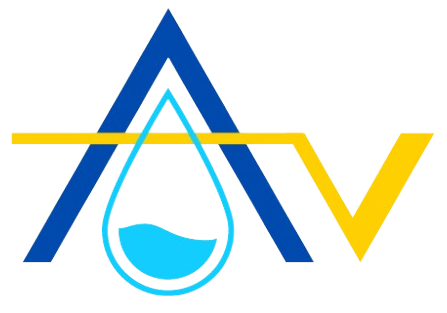Crawlspace Waterproofing: All You Should Know Before Do it

Crawlspace waterproofing is the process of preventing water, moisture, and humidity from entering the underfloor area located between the soil and the ground floor of a building. The main purpose of crawlspace waterproofing is to protect the underfloor space from water and maintain a healthy crawlspace.
You should waterproof the crawlspace when you observe water standing, mold and mildew growth, damp wall and floor, higher humidity, musty odor, efflorescence on walls, wood damage, insect infestation, paint peeling, and water stains in the crawlspace. This process includes crawlspace encapsulation, installing a sump pump, drainage, vapor barrier, dehumidifier in the crawlspace.
Crawlspace waterproofing requires a combination of essential materials, tools, and equipment to create a sealed and moisture-resistant environment. Crawlspace can be waterproofed by following the 9 steps below. Aqviz experts always recommend that you should not conduct this as a DIY project without expert observation, because it is more complex and you should have professional knowledge. Hence, it costs high. Aqviz experts have prepared this guide to understand the process. Aqviz experts can help you to do it. So contact us now.
What is Crawlspace Waterproofing?
Crawlspace waterproofing is the process of preventing water, moisture, and humidity from entering the underfloor area located between the soil and the ground floor of a building. Crawlspace waterproofing includes crawlspace inspection, cleaning, sealing vents, improving drains, sealing cracks and damages, installing a vapor barrier, adding insulation, and installing a dehumidifier. The main purpose of crawlspace waterproofing is to protect the underfloor space from water and maintain a healthy crawlspace.
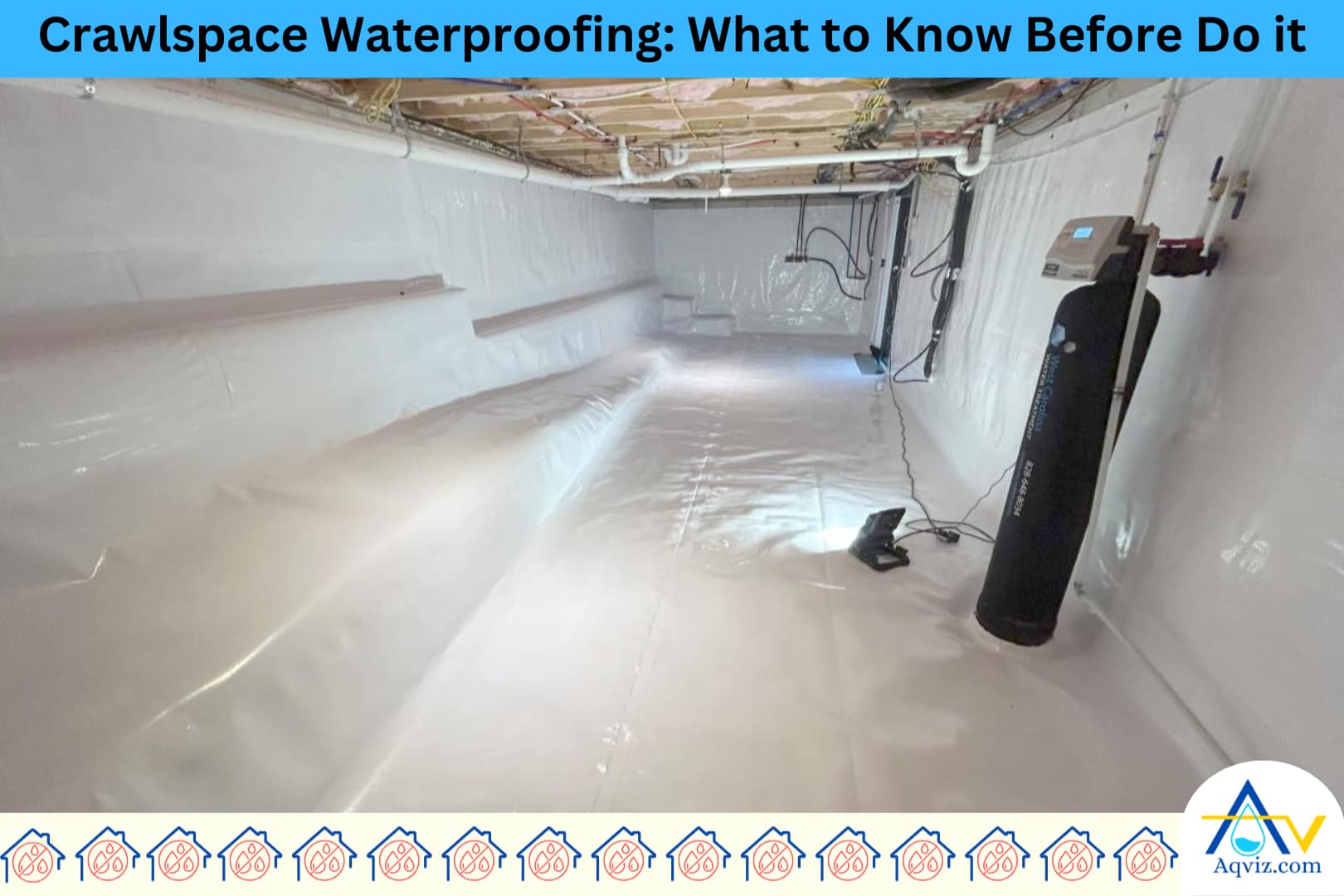
What are the 15 Signs that a Crawlspace needs Waterproofing?
These are 15 signs that a crawlspace needs waterproofing
- Standing water in the crawlspace
- Damp or wet crawlspace soil
- High humidity in the crawlspace
- Mold or mildew growth in crawlspace organic materials
- Musty odors in the home
- Efflorescence on crawlspace walls
- Rotting wood or floor joists
- Insect infestations (e.g., termites)
- Rust on the crawlspace metal components
- Condensation on crawlspace pipes or walls
- Sagging or uneven crawlspace floors above
- Cracks in foundation walls
- Water stains on walls or floors
- Peeling paint or bubbling in crawlspace walls
- White powdery substance (mineral deposits) outside the crawlspace walls
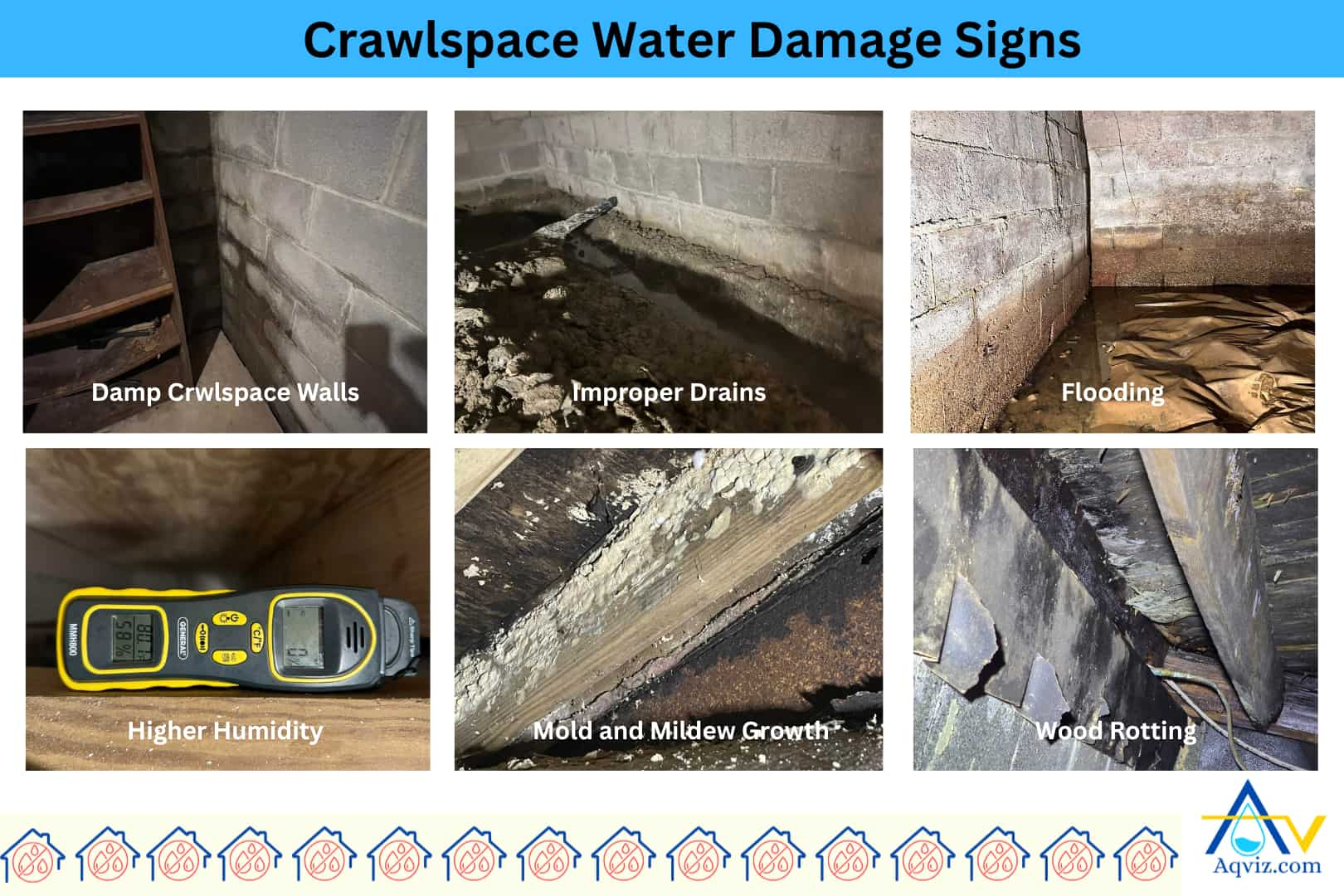
What is the Best method for Crawlspace Waterproofing?
The best crawlspace waterproofing method is encapsulation, which involves sealing the entire crawlspace with a heavy-duty vapor barrier and isolating it from external moisture sources. Crawlspace encapsulation covers the floor, foundation walls, and sometimes the ceiling with a polyethylene membrane (usually 12 to 20 mil thick), effectively locking out ground moisture, radon gas, and humid air.
Other effective crawlspace waterproofing methods include installing an interior French drain system, applying waterproof coatings to foundation walls, and using sump pumps to evacuate collected water.
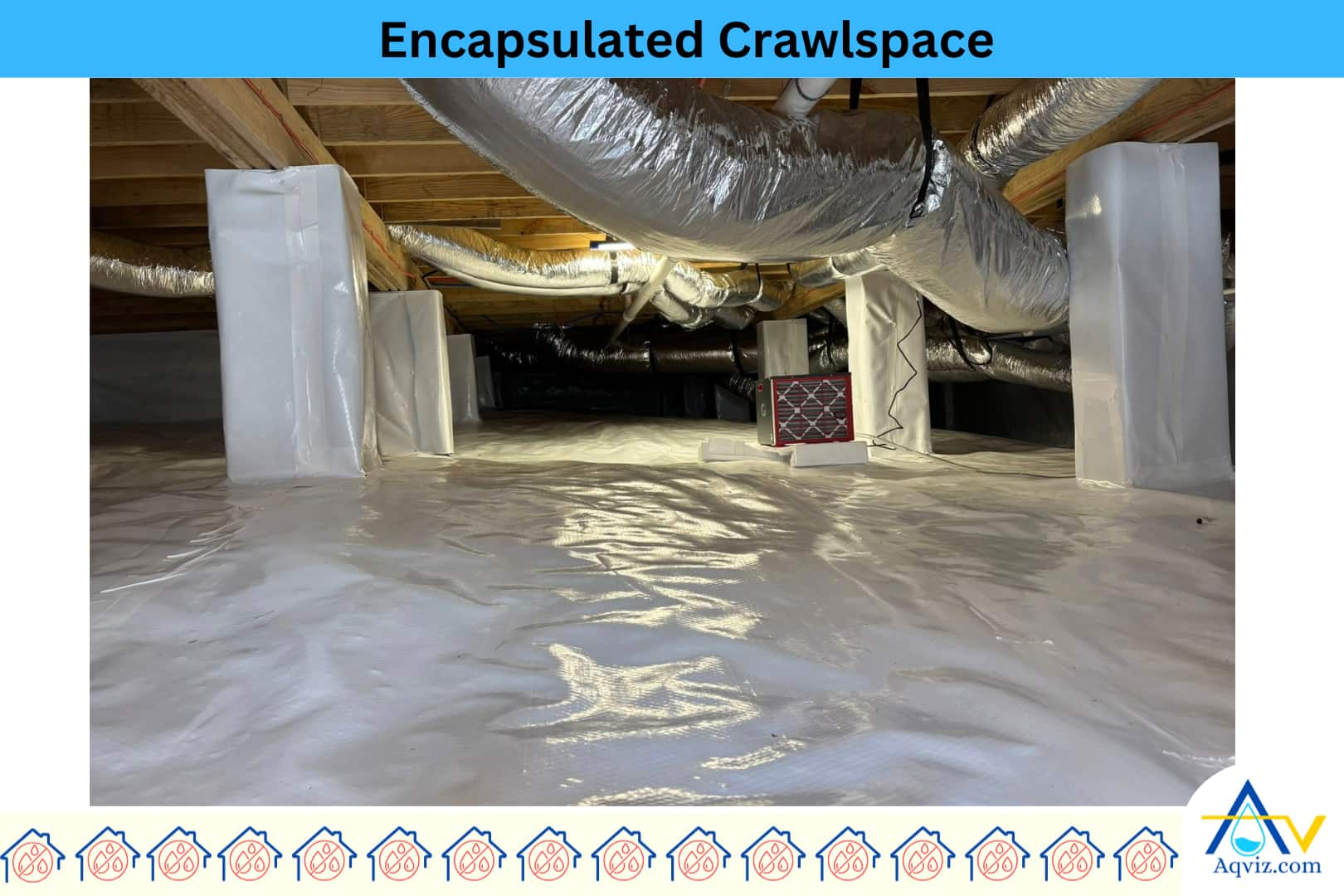
What Should you use to Waterproof a Crawlspace?
Crawlspace waterproofing requires a combination of essential materials, tools, and equipment to create a sealed and moisture-resistant environment.
- Safety gear: Safety tools, head lamps, and torches are essential for crawlspace inspections.
- Excavation tools: Excavation tools like shovel, trenching shovel, bucket, rake, hand trowel, mattock are essential for excavations in the crawlspace.
- Vapor barriers: Vapor barriers are typically made from reinforced polyethylene sheeting with a thickness of 12 to 20 mil, used to cover the floor and walls.
- Sealing tapes: Sealing tapes like waterproof tape, seam sealants, and polyurethane caulk are needed to secure seams and joints tightly.
- Sump pump, French drain, Dehumidifier: Sump pumps, French drains, and dehumidifiers are additional components that help to remove water and vapor from the crawlspace.
- Waterproofing membranes: Waterproofing membranes, and crack injections are essential to seal all the cracks, joints, voids, and damages in the crawlspace wall. These membranes block all the possible leaks and seepage in the crawlspace.
- Insulation boards: Insulation boards are used to improve thermal performance in the crawlspace.
How do you Waterproof a Crawlspace?
You should follow the below 9 methods for crawlspace waterproofing.
Step 1: Inspect the crawlspace
Crawlspace waterproofing starts with a full inspection to identify water damage, moisture sources, foundation cracks, plumbing leaks, and improper exterior grading.
Step 2: Clear and clean the crawlspace
Crawlspace waterproofing requires the removal of all debris, wet insulation, and standing water from the crawlspace floor. Dry the crawlspace using fans for 24-48 hours before waterproofing.
Step 3: Improve crawlspace drainage system
Crawlspace waterproofing includes installing a French drain and sump pump inside the crawlspace. Ensure downspouts discharge water at least 6 feet away from the foundation.
Step 4: Seal crawlspace vents and openings
Crawlspace waterproofing involves sealing exterior vents and openings around pipes, ducts, and rim joists using foam or rigid insulation to block air and moisture entry.
Step 5: Apply crawlspace wall waterproofing
Crawlspace waterproofing includes coating interior foundation walls with cementitious slurry or liquid-applied membrane to stop lateral moisture infiltration.
Step 6: Install crawlspace vapor barrier
Crawlspace waterproofing requires installing a 12-20 mil polyethylene vapor barrier over the crawlspace floor. Overlap seams by 12 inches and seal edges up the walls using fasteners and caulk.
Step 7: Add crawlspace insulation (optional)
Crawlspace waterproofing can be enhanced by applying rigid foam insulation boards to foundation walls. You should avoid fiberglass insulation, which absorbs moisture and promotes mold.
Step 8: Install a dehumidifier in the crawlspace
Crawlspace waterproofing uses a dehumidifier rated for crawlspaces to maintain humidity below 60%. Connect the dehumidifier to an auto-drain system and monitor with a hygrometer.
Step 9: Perform final crawlspace inspection and maintenance
Crawlspace waterproofing must include checking all seals, overlaps, and drainage components. Schedule inspections every 6-12 months to maintain the waterproofing system’s performance.
Read More About:
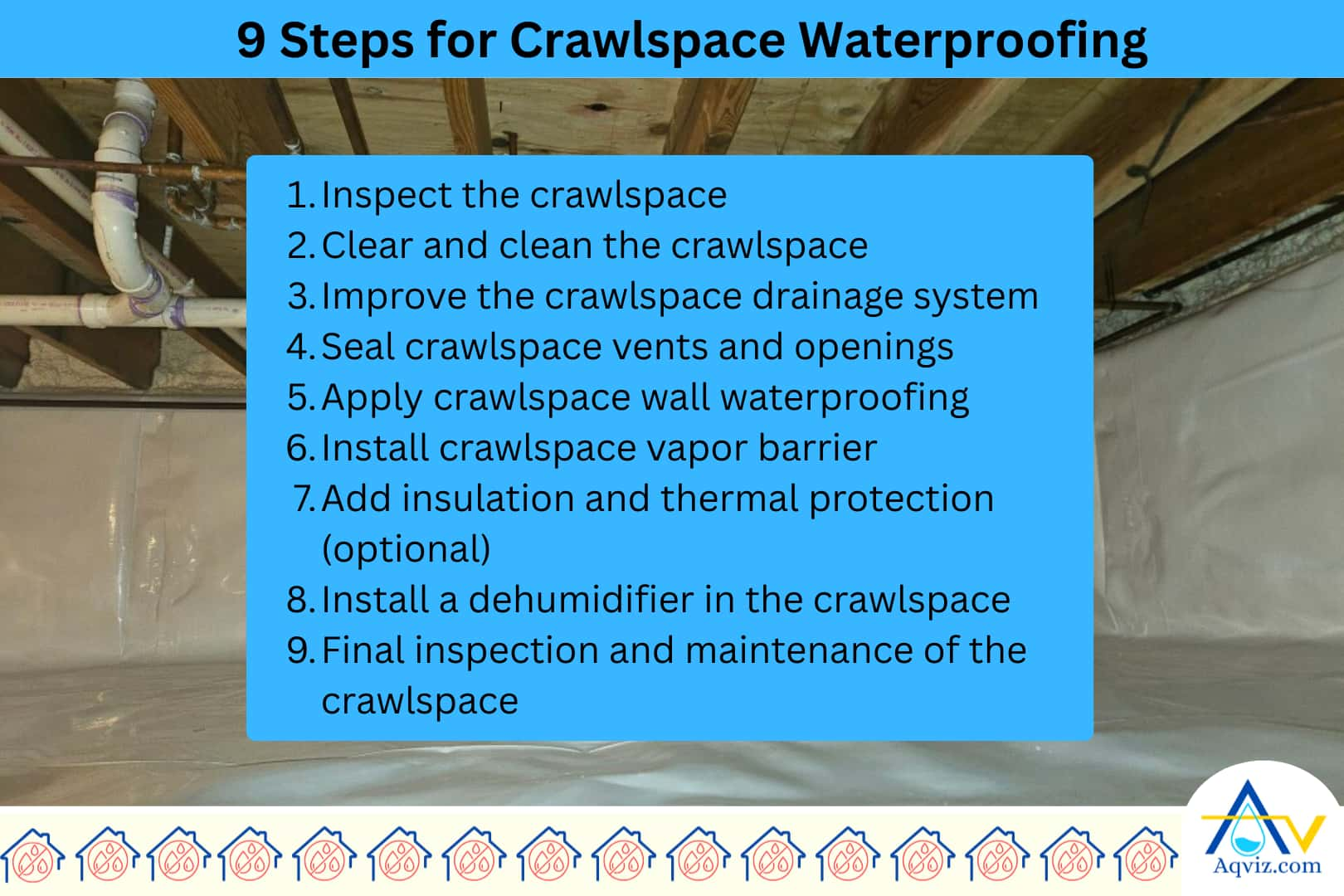
How Much Does it Cost to Waterproof a 1000 sq ft Crawlspace?
Crawlspace waterproofing for a 1,000 sq ft area typically costs between $5,000 and $15,000, depending on the system design, material quality, and site conditions. Basic crawlspace waterproofing with a vapor barrier averages $3 to $7 per sq ft, while full encapsulation with drainage, sump pump, and dehumidification ranges from $10 to $15 per sq ft.
The cost of crawlspace waterproofing increases due to severe water intrusion, foundation wall cracks, high groundwater levels, existing mold, and the use of premium materials such as 20-mil reinforced vapor barriers or commercial-grade drainage systems. Crawlspace waterproofing also becomes more expensive if access is limited or the floor height is below 18 inches.
Are Crawlspace Waterproofing and Encapsulation the Same?
Crawlspace waterproofing and crawlspace encapsulation are not the same.
Crawlspace waterproofing refers to a broad set of techniques used to prevent water intrusion and control moisture in the underfloor space. Crawlspace waterproofing may include drainage systems, vapor barriers, sump pumps, coatings, and dehumidifiers, depending on the moisture source and severity.
Crawlspace encapsulation involves sealing the entire cavity space using a continuous vapor barrier over the floor and walls, along with air sealing and humidity control. Crawlspace encapsulation creates a conditioned and isolated environment, while crawlspace waterproofing includes both partial and full protection methods.
What Happens if a Crawlspace is Not Waterproofed?
If the crawlspace is not waterproofed, it may cause below problems and damage.
- Mold and mildew growth in the crawlspace
- Wood rotting, wood warping, wood deterioration in the crawlspace
- Damage the foundation
- Increase the energy bills due to the use of HVAC systems in the crawlspace
- Increase pest infestation in the crawlspace
- Rise musty odor, unpleasant smell into the indoor air in the home
- Fail the insulation effectiveness
- Reduce the indoor air quality.
Read More About Crawlspace Water Damages
- Musty Crawl Space: Signs, Risks and Solutions
- Crawl Space Mold: Warning Signs, Damage and Removal Tips
- Crawl Space Flooding: Causes, Warning Signs and How to Fix
- Crawl Space Humidity: Ideal Levels, Damage Risks and Fixes
Can I Waterproof my Crawlspace (DIY)?
Crawlspace waterproofing is not recommended as a DIY project due to the technical complexity, safety risks, and long-term consequences of improper installation. Crawlspace waterproofing requires professional assessment of water intrusion sources, soil grading, foundation condition, and ventilation behavior, which DIY homeowners typically overlook or misjudge.
Does Interior Crawlspace Waterproofing Affect the Exterior?
Interior crawlspace waterproofing improves the moisture condition inside the subfloor area but does not directly resolve exterior water intrusion problems. Interior crawlspace waterproofing manages internal symptoms like standing water, condensation, and vapor buildup using methods such as vapor barriers, sump pumps, and dehumidifiers.
